|
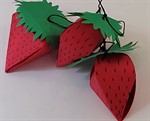 |  NY | Hands On: Celebrate Strawberry Moon NY | Hands On: Celebrate Strawberry MoonMany Native communities of the Northeast celebrate the harvest of strawberries in June and July. Learn about the significance and cultural traditions surrounding the strawberry for Indigenous communities and then create a paper strawberry to take home. All ages welcome. *Children 18 and under should be accompanied by an adult caregiver.  More info More info  Add to calendar Add to calendar  Forward to friends Forward to friends |
|
|
 |  NY | Hands On: Celebrate Strawberry Moon NY | Hands On: Celebrate Strawberry MoonMany Native communities of the Northeast celebrate the spring harvest of strawberries in June and July. The celebration often coincides with the full moon. Learn about the significance and cultural traditions surrounding the strawberry for Indigenous communities and then create a paper strawberry to take home. All ages welcome. *Children 18 and under should be accompanied by an adult caregiver.  More info More info  Add to calendar Add to calendar  Forward to friends Forward to friends |
|
|
 |  DC | Story Time DC | Story TimeFamilies are invited to an interactive story time featuring a children’s book by a Native author, illustrator, or created in collaboration with an Indigenous community. They will have the opportunity to engage with objects from the museum's Teaching Collection such as photographs, textiles, or natural materials that can deepen their understanding of the community represented in the story, along with a craft or other activity. *Due to limited capacity in our spaces, tickets may be needed to enter the Activity Center and therefore the Story room (limited to 25 persons max). Please see staff at the entrance desk of the imagiNATIONS Activity Center on Level 3. Recommended for visitors ages 3-9 years old accompanied by an adult caregiver.  More info More info  Add to calendar Add to calendar  Forward to friends Forward to friends |
|
|
 |  NY | Hands On: Celebrate Strawberry Moon NY | Hands On: Celebrate Strawberry MoonMany Native communities of the Northeast celebrate the spring harvest of strawberries in June and July. The celebration often coincides with the full moon. Learn about the significance and cultural traditions surrounding the strawberry for Indigenous communities and then create a paper strawberry to take home. All ages welcome. *Children 18 and under should be accompanied by an adult caregiver.  More info More info  Add to calendar Add to calendar  Forward to friends Forward to friends |
|
|
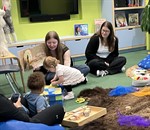 |  DC | Cradleboards and Crawlers DC | Cradleboards and CrawlersDesigned for early learners (ages 0-2), their caregivers, and families, this drop-in program offers young visitors the opportunity to enjoy a book by a Native author or illustrator read by a Museum Educator, engage in free play and sensory enrichment, and participate in other hands-on learning.
*Due to limited capacity in our spaces, tickets may be needed to enter the Activity Center and therefore the Story room (limited to 25 persons max). Please see staff at the entrance desk of the imagiNATIONS Activity Center on Level 3.
**Recommended for visitors ages 0-2 years old accompanied by an adult caregiver.  More info More info  Add to calendar Add to calendar  Forward to friends Forward to friends |
|
|
 |  DC | Welcome to a Native Place DC | Welcome to a Native PlaceEnjoy tribal songs from Alaska to Florida with Dennis Zotigh (Kiowa/Isanti Dakota/Ohkay Owingeh Pueblo) in the Potomac Atrium. At the end of the 30-minute presentation, visitors are encouraged to ask questions pertaining to the museum and Indigenous culture, past and present. Presentations may be canceled without prior notice.  More info More info  Add to calendar Add to calendar  Forward to friends Forward to friends |
|
|
 |  DC | Cradleboards and Crawlers DC | Cradleboards and CrawlersDesigned for early learners (ages 0-2), their caregivers, and families, this drop-in program offers young visitors the opportunity to enjoy a book by a Native author or illustrator read by a Museum Educator, engage in free play and sensory enrichment, and participate in other hands-on learning.
*Due to limited capacity in our spaces, tickets may be needed to enter the Activity Center and therefore the Story room (limited to 25 persons max). Please see staff at the entrance desk of the imagiNATIONS Activity Center on Level 3.
**Recommended for visitors ages 0-2 years old accompanied by an adult caregiver.  More info More info  Add to calendar Add to calendar  Forward to friends Forward to friends |
|
|
 |  DC | Welcome to a Native Place DC | Welcome to a Native PlaceEnjoy tribal songs from Alaska to Florida with Dennis Zotigh (Kiowa/Isanti Dakota/Ohkay Owingeh Pueblo) in the Potomac Atrium. At the end of the 30-minute presentation, visitors are encouraged to ask questions pertaining to the museum and Indigenous culture, past and present. Presentations may be canceled without prior notice.  More info More info  Add to calendar Add to calendar  Forward to friends Forward to friends |
|
|
 |  DC | Cradleboards and Crawlers DC | Cradleboards and CrawlersDesigned for early learners (ages 0-2), their caregivers, and families, this drop-in program offers young visitors the opportunity to enjoy a book by a Native author or illustrator read by a Museum Educator, engage in free play and sensory enrichment, and participate in other hands-on learning.
*Due to limited capacity in our spaces, tickets may be needed to enter the Activity Center and therefore the Story room (limited to 25 persons max). Please see staff at the entrance desk of the imagiNATIONS Activity Center on Level 3.
**Recommended for visitors ages 0-2 years old accompanied by an adult caregiver.  More info More info  Add to calendar Add to calendar  Forward to friends Forward to friends |
|
|
 |  DC | Welcome to a Native Place DC | Welcome to a Native PlaceEnjoy tribal songs from Alaska to Florida with Dennis Zotigh (Kiowa/Isanti Dakota/Ohkay Owingeh Pueblo) in the Potomac Atrium. At the end of the 30-minute presentation, visitors are encouraged to ask questions pertaining to the museum and Indigenous culture, past and present. Presentations may be canceled without prior notice.  More info More info  Add to calendar Add to calendar  Forward to friends Forward to friends |
|
|
 |  DC | Cradleboards and Crawlers DC | Cradleboards and CrawlersDesigned for early learners (ages 0-2), their caregivers, and families, this drop-in program offers young visitors the opportunity to enjoy a book by a Native author or illustrator read by a Museum Educator, engage in free play and sensory enrichment, and participate in other hands-on learning.
*Due to limited capacity in our spaces, tickets may be needed to enter the Activity Center and therefore the Story room (limited to 25 persons max). Please see staff at the entrance desk of the imagiNATIONS Activity Center on Level 3.
**Recommended for visitors ages 0-2 years old accompanied by an adult caregiver.  More info More info  Add to calendar Add to calendar  Forward to friends Forward to friends |
|
|
 |  DC | Welcome to a Native Place DC | Welcome to a Native PlaceEnjoy tribal songs from Alaska to Florida with Dennis Zotigh (Kiowa/Isanti Dakota/Ohkay Owingeh Pueblo) in the Potomac Atrium. At the end of the 30-minute presentation, visitors are encouraged to ask questions pertaining to the museum and Indigenous culture, past and present. Presentations may be canceled without prior notice.  More info More info  Add to calendar Add to calendar  Forward to friends Forward to friends |
|
|
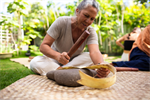 |  DC | Children's Kapa Workshop with Page Chang DC | Children's Kapa Workshop with Page ChangLearn the art of Hawaiian kapa making with Kumu (teacher) Page Chang of Pūkoʻa Studios from Waimānalo, Hawaii. Made primarily from the paper mulberry or "wauke," kapa (barkcloth) is the traditional fabric of Hawai‘i. Brought to Hawai‘i by Polynesian voyagers more than a thousand years ago, wauke is still grown and harvested locally on the islands. The outer bark of the stalk is stripped and the baste, or inner bark, is peeled, pounded over a rock with a wooden mallet, and set in water to ferment. Additional hand-carved wooden beaters called i‘e kuku are used to spread the bark into a thin cloth, which is then dried and decorated to create fabric for use in clothing, artwork, adornments, and more. Participants will have the opportunity to strip a branch of wauke and pound the baste fiber with traditional tools, and to make and take home their own piece of kapa. All ages welcome. *Visitors 18 and under must be accompanied by an adult. First come, first served, capacity and supplies are limited.  More info More info  Add to calendar Add to calendar  Forward to friends Forward to friends |
|
|
 |  DC | Children's Kapa Workshop with Page Chang DC | Children's Kapa Workshop with Page ChangLearn the art of Hawaiian kapa making with Kumu (teacher) Page Chang of Pūkoʻa Studios from Waimānalo, Hawaii. Made primarily from the paper mulberry or "wauke," kapa (barkcloth) is the traditional fabric of Hawai‘i. Brought to Hawai‘i by Polynesian voyagers more than a thousand years ago, wauke is still grown and harvested locally on the islands. The outer bark of the stalk is stripped and the baste, or inner bark, is peeled, pounded over a rock with a wooden mallet, and set in water to ferment. Additional hand-carved wooden beaters called i‘e kuku are used to spread the bark into a thin cloth, which is then dried and decorated to create fabric for use in clothing, artwork, adornments, and more. Participants will have the opportunity to strip a branch of wauke and pound the baste fiber with traditional tools, and to make and take home their own piece of kapa. All ages welcome. *Visitors 18 and under must be accompanied by an adult. First come, first served, capacity and supplies are limited.  More info More info  Add to calendar Add to calendar  Forward to friends Forward to friends |
|
|
 |  DC | Children's Kapa Workshop with Page Chang DC | Children's Kapa Workshop with Page ChangLearn the art of Hawaiian kapa making with Kumu (teacher) Page Chang of Pūkoʻa Studios from Waimānalo, Hawaii. Made primarily from the paper mulberry or "wauke," kapa (barkcloth) is the traditional fabric of Hawai‘i. Brought to Hawai‘i by Polynesian voyagers more than a thousand years ago, wauke is still grown and harvested locally on the islands. The outer bark of the stalk is stripped and the baste, or inner bark, is peeled, pounded over a rock with a wooden mallet, and set in water to ferment. Additional hand-carved wooden beaters called i‘e kuku are used to spread the bark into a thin cloth, which is then dried and decorated to create fabric for use in clothing, artwork, adornments, and more. Participants will have the opportunity to strip a branch of wauke and pound the baste fiber with traditional tools, and to make and take home their own piece of kapa. All ages welcome. *Visitors 18 and under must be accompanied by an adult. First come, first served, capacity and supplies are limited.  More info More info  Add to calendar Add to calendar  Forward to friends Forward to friends |
|
|
 |  DC | Children's Kapa Workshop with Page Chang DC | Children's Kapa Workshop with Page ChangLearn the art of Hawaiian kapa making with Kumu (teacher) Page Chang of Pūkoʻa Studios from Waimānalo, Hawaii. Made primarily from the paper mulberry or "wauke," kapa (barkcloth) is the traditional fabric of Hawai‘i. Brought to Hawai‘i by Polynesian voyagers more than a thousand years ago, wauke is still grown and harvested locally on the islands. The outer bark of the stalk is stripped and the baste, or inner bark, is peeled, pounded over a rock with a wooden mallet, and set in water to ferment. Additional hand-carved wooden beaters called i‘e kuku are used to spread the bark into a thin cloth, which is then dried and decorated to create fabric for use in clothing, artwork, adornments, and more. Participants will have the opportunity to strip a branch of wauke and pound the baste fiber with traditional tools, and to make and take home their own piece of kapa. All ages welcome. *Visitors 18 and under must be accompanied by an adult. First come, first served, capacity and supplies are limited.  More info More info  Add to calendar Add to calendar  Forward to friends Forward to friends |
|
|
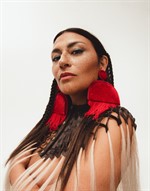 |  NY | Native Sounds Downtown with Elisapie NY | Native Sounds Downtown with ElisapieBring your friends and family for a fun concert featuring acclaimed Inuit artist Elisapie, who will be performing live in French, English, and her beloved mother tongue, Inuktitut at the National Museum of the American Indian. With unconditional love for her Inuit homeland, culture is entrenched in her work as storyteller, singer-songwriter, actor, and director. Elisapie was born and raised in Salluit, a small village in Nunavik, in northern Quebec, Canada.
Elisapie earned a Juno Award in the Contemporary Indigenous Artist of the Year category, as well as five awards at the 2024 ADISQ (Association québécoise de l'industrie du disque, du spectacle et de la vidéo/Québec Association for the Recording, Concert and Video Industries) Gala. Her album Inuktitut, which covers ten classic rock and pop songs from a wide array of artists including Metallica, Pink Floyd, Fleetwood Mac, Cyndi Lauper and more, all performed in Inuktitut, was nominated at the 2025 Juno Award for Best Album of the year and was awarded Best Adult Alternative Album of the year. An acclaimed documentarian, Elisapie is the creator of Le grand solstice, a musical and cultural celebration televised annually to mark National Indigenous Peoples Day. In 2024, the Canada Post recognized Elisapie with a Permanent™ stamp in their Indigenous Leaders series which honors the outstanding achievements and contributions of First Nations, Inuit and Métis leaders.
Image credit: Leeor Wild
 More info More info  Add to calendar Add to calendar  Forward to friends Forward to friends |
|
|
 |  DC | Children's Kapa Workshop with Page Chang DC | Children's Kapa Workshop with Page ChangLearn the art of Hawaiian kapa making with Kumu (teacher) Page Chang of Pūkoʻa Studios from Waimānalo, Hawaii. Made primarily from the paper mulberry or "wauke," kapa (barkcloth) is the traditional fabric of Hawai‘i. Brought to Hawai‘i by Polynesian voyagers more than a thousand years ago, wauke is still grown and harvested locally on the islands. The outer bark of the stalk is stripped and the baste, or inner bark, is peeled, pounded over a rock with a wooden mallet, and set in water to ferment. Additional hand-carved wooden beaters called i‘e kuku are used to spread the bark into a thin cloth, which is then dried and decorated to create fabric for use in clothing, artwork, adornments, and more. Participants will have the opportunity to strip a branch of wauke and pound the baste fiber with traditional tools, and to make and take home their own piece of kapa. All ages welcome. *Visitors 18 and under must be accompanied by an adult. First come, first served, capacity and supplies are limited.  More info More info  Add to calendar Add to calendar  Forward to friends Forward to friends |
|
|
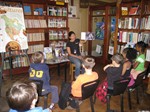 |  NY | Story Time NY | Story TimeFamilies are invited to an interactive story time on the second Saturday of each month* featuring a children’s book by a Native author, illustrator, or created in collaboration with an Indigenous community. They will have the opportunity to engage with objects from the museum's teaching collection, such as photographs, textiles, or natural materials, which can deepen their understanding of the community represented in the story, along with a craft or other activity. All are welcome. Recommended for visitors ages 3–9 years old accompanied by an adult caregiver.
*Schedule subject to change.  More info More info  Add to calendar Add to calendar  Forward to friends Forward to friends |
|
|
 |  DC | Children's Kapa Workshop with Page Chang DC | Children's Kapa Workshop with Page ChangLearn the art of Hawaiian kapa making with Kumu (teacher) Page Chang of Pūkoʻa Studios from Waimānalo, Hawaii. Made primarily from the paper mulberry or "wauke," kapa (barkcloth) is the traditional fabric of Hawai‘i. Brought to Hawai‘i by Polynesian voyagers more than a thousand years ago, wauke is still grown and harvested locally on the islands. The outer bark of the stalk is stripped and the baste, or inner bark, is peeled, pounded over a rock with a wooden mallet, and set in water to ferment. Additional hand-carved wooden beaters called i‘e kuku are used to spread the bark into a thin cloth, which is then dried and decorated to create fabric for use in clothing, artwork, adornments, and more. Participants will have the opportunity to strip a branch of wauke and pound the baste fiber with traditional tools, and to make and take home their own piece of kapa. All ages welcome. *Visitors 18 and under must be accompanied by an adult. First come, first served, capacity and supplies are limited.  More info More info  Add to calendar Add to calendar  Forward to friends Forward to friends |
|
|
 |  DC | Children's Kapa Workshop with Page Chang DC | Children's Kapa Workshop with Page ChangLearn the art of Hawaiian kapa making with Kumu (teacher) Page Chang of Pūkoʻa Studios from Waimānalo, Hawaii. Made primarily from the paper mulberry or "wauke," kapa (barkcloth) is the traditional fabric of Hawai‘i. Brought to Hawai‘i by Polynesian voyagers more than a thousand years ago, wauke is still grown and harvested locally on the islands. The outer bark of the stalk is stripped and the baste, or inner bark, is peeled, pounded over a rock with a wooden mallet, and set in water to ferment. Additional hand-carved wooden beaters called i‘e kuku are used to spread the bark into a thin cloth, which is then dried and decorated to create fabric for use in clothing, artwork, adornments, and more. Participants will have the opportunity to strip a branch of wauke and pound the baste fiber with traditional tools, and to make and take home their own piece of kapa. All ages welcome. *Visitors 18 and under must be accompanied by an adult. First come, first served, capacity and supplies are limited.  More info More info  Add to calendar Add to calendar  Forward to friends Forward to friends |
|
|
 |  NY | Story Time NY | Story TimeFamilies are invited to an interactive story time on the second Saturday of each month* featuring a children’s book by a Native author, illustrator, or created in collaboration with an Indigenous community. They will have the opportunity to engage with objects from the museum's Teaching Collection such as photographs, textiles, or natural materials that can deepen their understanding of the community represented in the story, along with a craft or other activity. All are welcome. Recommended for visitors ages 3-9 years old accompanied by an adult caregiver.
*Schedule subject to change.
Image: Photo by Matailong Du for the National Museum of the American Indian.  More info More info  Add to calendar Add to calendar  Forward to friends Forward to friends |
|
|
 |  DC | Children's Kapa Workshop with Page Chang DC | Children's Kapa Workshop with Page ChangLearn the art of Hawaiian kapa making with Kumu (teacher) Page Chang of Pūkoʻa Studios from Waimānalo, Hawaii. Made primarily from the paper mulberry or "wauke," kapa (barkcloth) is the traditional fabric of Hawai‘i. Brought to Hawai‘i by Polynesian voyagers more than a thousand years ago, wauke is still grown and harvested locally on the islands. The outer bark of the stalk is stripped and the baste, or inner bark, is peeled, pounded over a rock with a wooden mallet, and set in water to ferment. Additional hand-carved wooden beaters called i‘e kuku are used to spread the bark into a thin cloth, which is then dried and decorated to create fabric for use in clothing, artwork, adornments, and more. Participants will have the opportunity to strip a branch of wauke and pound the baste fiber with traditional tools, and to make and take home their own piece of kapa. All ages welcome. *Visitors 18 and under must be accompanied by an adult. First come, first served, capacity and supplies are limited.  More info More info  Add to calendar Add to calendar  Forward to friends Forward to friends |
|
|
 |  DC | Cradleboards and Crawlers DC | Cradleboards and CrawlersDesigned for early learners (ages 0-2), their caregivers, and families, this drop-in program offers young visitors the opportunity to enjoy a book by a Native author or illustrator read by a Museum Educator, engage in free play and sensory enrichment, and participate in other hands-on learning.
*Due to limited capacity in our spaces, tickets may be needed to enter the Activity Center and therefore the Story room (limited to 25 persons max). Please see staff at the entrance desk of the imagiNATIONS Activity Center on Level 3.
**Recommended for visitors ages 0-2 years old accompanied by an adult caregiver.  More info More info  Add to calendar Add to calendar  Forward to friends Forward to friends |
|
|
 |  DC | Welcome to a Native Place DC | Welcome to a Native PlaceEnjoy tribal songs from Alaska to Florida with Dennis Zotigh (Kiowa/Isanti Dakota/Ohkay Owingeh Pueblo) in the Potomac Atrium. At the end of the 30-minute presentation, visitors are encouraged to ask questions pertaining to the museum and Indigenous culture, past and present. Presentations may be canceled without prior notice.  More info More info  Add to calendar Add to calendar  Forward to friends Forward to friends |
|